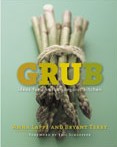Most people spend a lot of time thinking about food. They think about meals they need to plan for their families, food they need to add to their grocery list, new restaurants they need to try, and the carb and calories counts of the foods they love. They have a lot of opinions about their food and what they like and dislike. But many are still not thinking about food in a meaningful way. They are not thinking about where their food comes from, how it gets to them, under what circumstances, and at what cost. There are social, environmental, and ethical considerations that often go un-noticed.
That is why I think Grub Ideas for an Urban Organic Kitchen is one of the most important books I have ever read. For me, it is as meaningful and important at Rachel Carson’s work in Silent Spring. This book is a ground breaking, whistle blowing, expose on all of the fake food that fills our supermarkets and all of the very compelling reasons we NEED to start choosing organic, local, and fair foods. It is written by Anne Lappe, the co-founder of The Small Planet Institute and Bryant Terry a chef and founder of b-healthy a non-profit organization based in New York City. Both of the authors are food justice activists. They work together to create a guide for the young, the hip, the socially tuned-in, and for all who want to eat real food.
After reading this book you will no longer be able to look at food the same way. As Eric Schlosser (of Fast Food Nation) writes in the forward section, “What we eat has changed more in the last 30 years then in the previous thirty thousand. Trans fats, genetically engineered soybeans, livestock pumped with growth hormones and fed slaughterhouse waste, Chicken McNuggets nobody’s eaten this stuff before. We have become a nation of guinea pigs, the subjects of a vast scientific experiment, waiting to see what happens when humans eat to much industrialized food.”
As I read the book I kept remembering the words spoken by the character Morpheus in the popular movie The Matrix, “How far down the rabbit hole are you willing to go?” If you are ready to go down the rabbit hole and find out the truth about the foods we eat and the industry behind the food then forget about the red pill – read this book and you will be living in Wonderland no longer.
The book starts out by exposing the six illusions that many have about their food and it goes on to give us a huge wake up call. This book addresses the pesticides used on our food and exposes the large food corporations for their deplorable and greedy practices. The evidence in the book is backed up by numerous cited resources and provides some eye opening if not downright terrifying information that an unsuspecting public of food consumers really NEEDS to know about the food they eat and the mega corporations that are supplying it. This book shows us that eating has become not just a necessity for life but a political act. As Lappe says, “Our food choices, conscious or not, shape our world”.
One particular quote that seems to sum it all up is taken from John Kinsman, a Wisconsin organic dairy farmer that says “Every time you spend money on food you are voting for the world you want.”
After several chapters of eye opening details about all the fake food filling our supermarkets and the heinous political actions of the food industry, the book goes on to explain the correlation between organics and your health. I especially love the fact that this book points out that shifting our diet in a healthier direction doesn’t mean we get it right 100% of the time. The key is to develop habits that make it easier for us to have good days and harder to have bad days.
The latter half of the book contains a series of menus for every season, complete with recipes, soundtracks to cook and eat by, and artwork and poetry that evokes the spirit of eating Grub.
Truly, this is an organic food user’s guide and no conscious food consumer can let this book go unread. I have already decided that this book will make the perfect gift for friends and family who often inquire about my strange eating habits. Hopefully I can share this book with as many people as possible and help them see a need to join the revolution of people who want to change food and farming, creating better health and a better world.



The concept of healthy eating is primarily a problem in rich countries where the lifestyle includes little physical exercise, a large food intake, and a trend towards factory-processed foods instead of home-cooked meals. A healthy and rich resource for organic foods: http://www.realfreshfood.com/natural-food/nggfood.htm
Healthy eating is identical to a healthy diet, in that it relates to the practice of food intake for healthy living. Governments often use this term to refer to the ideal diet which the average person requires to remain healthy. A healthy and rich resource for organic foods: http://www.realfreshfood.com/local/health-food.htm
Pingback: Fair Food Advocate » Book Review: Grub